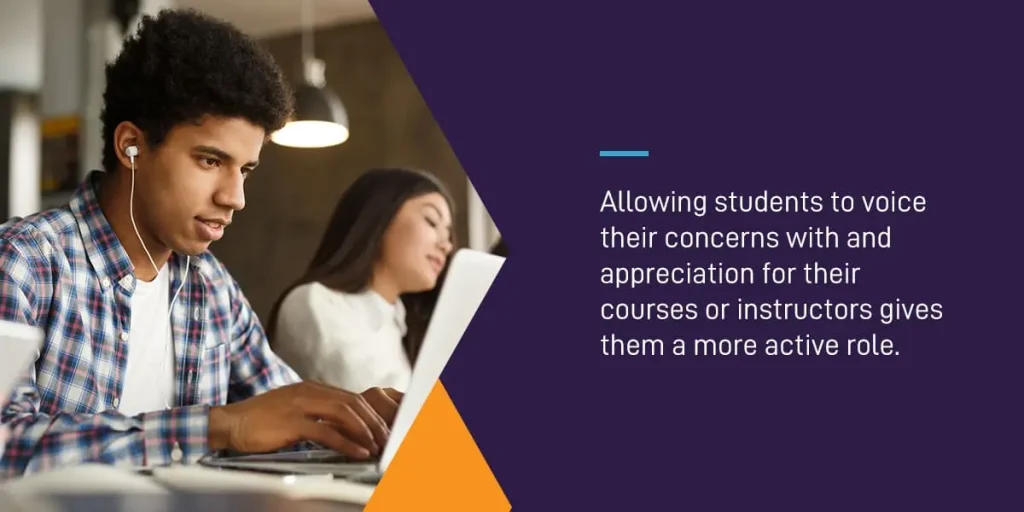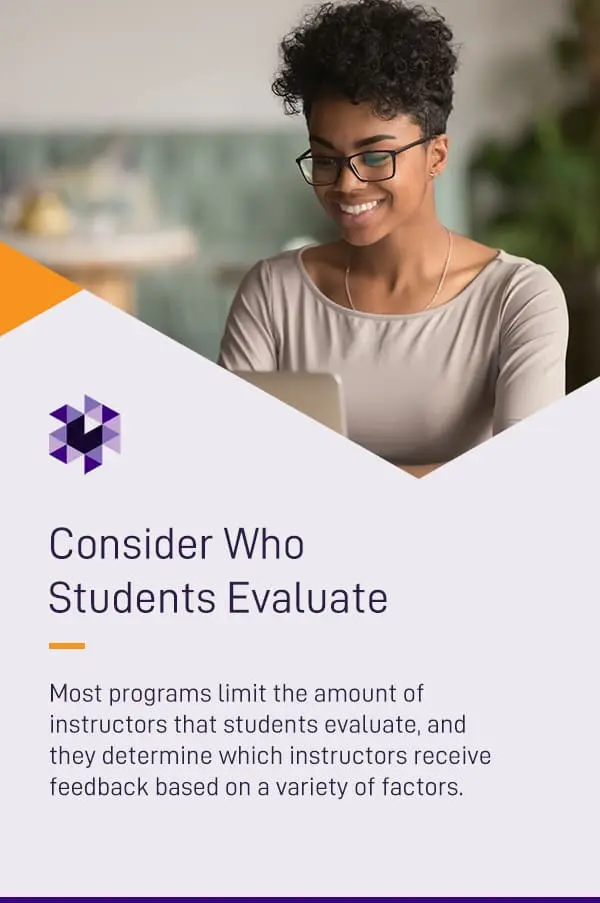




An increasing number of higher education institutions have begun administering online course evaluations for their students. As students and instructors learn to navigate unfamiliar learning environments, especially those which are entirely virtual, course evaluations open a line of communication to help professors become more effective in these environments and give students an active role in their education.
Course evaluations encourage self-reflection among students, faculty, and staff, which drives growth and development. Effective survey solutions allow a department or campus to get a read on the student population, which encourages constant change for the better.
Course evaluations are anonymous surveys completed by students, usually at the end of a term, to reflect on the efficacy of an instructor and the course. University course evaluations provide a wide variety of benefits. Some universities create a course evaluation template to rely on each year as they gather students’ feedback. After students have responded to the course evaluations, administrators receive the results. This data set includes information from student evaluation of courses to help improve the course in the future.

Online course evaluations provide numerous benefits for students, teachers, and staff administrators. Regardless of when a professor administers course evaluations – usually mid-semester or the end of term – they can receive valuable feedback from their students to help improve their instruction style. Students also have the opportunity to communicate concerns or appreciation for their professors, giving them a voice and making them active participants in the classroom. Administration can collect information from student course evaluations to evaluate a professor in conjunction with other information.

Students highly value anonymity when they give their professors feedback, especially when they criticize aspects of their teaching. Anonymity ensures students that their comments cannot be attributed to them in particular, which allows them to feel more comfortable expanding on their honest insights on their course or teacher.
In one study demonstrating the benefits of course evaluations, the researchers distributed different kinds of surveys to determine which factors most heavily contributed to responses and how to optimize student participation. They selected each online platform to manipulate different variables, but every platform allowed students to anonymously report their feedback. This demonstrates the inherent importance of allowing students to offer insights without attaching their contributions to their identity.
Administrators should prioritize anonymity in all aspects of the evaluation collection. This includes maintaining the privacy of students and their thoughts throughout data collection. A course evaluation survey solution should allow you to reopen or reset responses while maintaining the anonymity of the response and allow role-based permissions that you can customize to limit who has access to results and information.

Many people believe that online course evaluations yield a higher amount of negative feedback than paper-based surveys. However, studies have proven this to be a misconception. Researchers did not identify consistent, significant differences between evaluations submitted online and those which students completed on paper. In general, overall trends in evaluations remain consistent between surveys submitted on paper and online.
However, online course evaluations do show a higher rate of meaningful comments from students. In one study, less than 10% of students provided open-ended commentary about their course or professor when the professor administered the evaluation on paper during their class. However, the same study showed that 63% of students who completed and submitted the survey online offered long-form or open-ended commentary.
Longer commentary supplied in course evaluations by students allows for more active responses by professors. Optimal course evaluations include a limited number of questions, which means that, in order to get a more comprehensive understanding of student insights from the survey, respondents need to provide open-ended commentary. Conducting course evaluations online encourages students to contribute additional insights and supplies more constructive feedback for teachers.
Most course evaluations are administered online, and with good reason. Electronic survey collection platforms offer greater flexibility for students to complete the evaluations outside of the classroom. They also allow a respondent to take all the time they need – they can take breaks, spend time thinking about their answers, and dedicate a longer period for writing their responses. Additionally, they avoid the stress of completing their evaluation first or last and making their response easier to identify.

Students and teachers alike benefit from course evaluations because of the necessary self-refection. In order to provide meaningful feedback, students must consider both their instructor’s performance and the demonstrated commitment they had to the course. Respondents reflect on their performance throughout the term to determine which aspects of the course they enjoyed and disliked, while factoring in how their attitude and performance impacted those experiences. This allows them to provide constructive feedback for their professors and brainstorm how they can perform better as a student in the next term.
Constructive feedback allows professors to reflect on their performance throughout the term. Newer instructors with limited teaching experience especially benefit from the evaluations. Instructors can compare their own assessment of their performance with the feedback provided by their students to more accurately determine the effectiveness of their efforts throughout the term. Well-made evaluations create actionable goals for instructors to help them develop and grow over time.
Online course evaluations are much more environmentally friendly than their paper counterparts. Printing hundreds of evaluations uses significant amounts of paper, and students are becoming increasingly environmentally conscious. Many schools also have a commitment to environmentally sustainable practices, so you can uphold this statement by opting for online course evaluations. Paper evaluations also cost much more than an online survey platform. Save money by implementing efficient virtual course evaluations.
Loose paper also gets misplaced or lost easily, which means that students must either complete the evaluation during valuable class time or keep careful track of the paper. When the sheets get lost, either the school uses more funds to replace them or forfeits the feedback. Many students likely avoid requesting a new copy of the evaluation sheet, which means that they opt out of submitting an evaluation altogether.
6. Acquire Metrics for Teacher Evaluation

While short-term goal setting and self-reflection offers great benefits for students and teachers alike, course evaluations collected over time also provide a metric for long-term instructor evaluation. Faculty may refer to the course evaluations for a newer instructor or individual with less teaching experience to determine whether they are prepared for advancement. Combined with other types of evaluation, such as in situ observation, course evaluation surveys provide valuable insights for contract renewal considerations and advancement opportunities.
Course evaluations also come into play for tenure-track faculty who may be considered for promotions. The most important factor for determining an instructor’s effectiveness in the classroom boils down to overall trends. Student feedback contributes to these evaluation metrics and may also complement other factors like general score trends and patterns for specific courses.
Administration values the information gathered from course evaluations, but instructors may also review the feedback provided to track their own growth and development over time. Regardless of whether they do so for specific goal measurement, they can determine whether the changes they have made over time have had positive effects for their students. This becomes especially important as instructors navigate unfamiliar online learning environments.
Whereas paper evaluations require manual calculation of results, online course evaluations aggregate information automatically and, consequently, much more quickly. This saves significant amounts of time and offers the perk of real-time access to data. Immediate insights allow for quicker responses and easier decision-making. Good survey solutions allow administrators to aggregate and disaggregate data according to certain filters and criteria. This allows you to sift through the data and pull relevant information more easily.
The ability to generate reports, compare feedback data over time, and organize results based on demographic information allows you to have a more comprehensive view of the feedback students provide.

Allowing students to provide feedback about their courses and instructors demonstrates that the institution cares about their experience in the classroom. Students seeking higher education dedicate extensive time and effort to obtaining their degree, just as instructors spend hours preparing lessons and class materials, meeting with students to ensure their success, and evaluating submitted coursework.
Allowing students to voice their concerns with and appreciation for their courses or instructors gives them a more active role. Rather than centering classrooms around professors, shift the focus to the students and allow them to contribute to their educational experience.
Course evaluations offer many benefits, but only when done correctly. There are some essential steps that you must take in order to create an effective course evaluation for students. We collected seven considerations you should make as you create a plan for an effective course evaluation.
Determine what kind of data you aim to gather with the students’ course evaluations. Some of the most common goals may include evaluating teacher effectiveness, collecting data for teacher training, and providing focus points for specific aspects of the classroom experience.
Establish the criteria for good teaching to ensure that you sort data according to those expectations. The definition of good teaching varies, but many programs fall back on the outline of scholarly teaching, which relies on six standards – clear goals, adequate preparation, appropriate methods, significant results, effective presentation, and reflective critique.
After deciding upon the criteria to prioritize in evaluations, create questions that help collect data pertaining to those standards. Because general academia has not come to an agreement on how to reliably determine teaching effectiveness, it lacks a standard course evaluation template. However, you should aim to ask questions that address a single criterion in your teaching standards. Avoid questions that ask respondents to address more than one aspect of a teacher’s performance, and stay clear of leading questions that introduce bias.

After establishing the criteria that the evaluation aims to address, decide how many questions to include in the survey. Too few questions limit the amount of data that faculty receive, but too many questions deter students from submitting feedback because of survey fatigue. While it may be tempting to create a long survey that supplies comprehensive results, this decreases response rates.
Many course evaluation surveys divide the questions among the different standards of teaching effectiveness they aim to address. Assign a specific amount of questions to each category you want to measure and create questions that address that particular aspect of the classroom or instruction. Ensure that you elicit information that will be conducive to achieving your goals. This means that you should think carefully about how you will consider the data after collecting it and have a thorough understanding of how to analyze your findings.
Consider stating the amount of questions in the initial instructions of the survey. This prepares respondents for the length of the evaluation, so they can determine whether they will have enough time to thoroughly respond to the prompts.
Question clarity plays an essential role in the types of responses collected in a survey. When students misunderstand the questions, their answers are less meaningful to the data set. However, there is no way to know that students misunderstood the question when they answered, which means that analyzing the data provided may lead to skewed results.
To prevent misleading questions, ensure that the questions you include specifically address aspects of effective teaching that students can observe in the classroom. Although an instructor’s expertise in a subject directly impacts their ability to proficiently teach it, many students would be unable to judge the extent of a professor’s expertise. However, students observe and are directly affected by an instructor’s enthusiasm about the subject and their ability to explain the concepts in a practical, digestible fashion.
To ensure clarity, obtain feedback from a small group of randomly selected students about the question quality before making the evaluation public to everyone. You may also consider allowing survey respondents to provide commentary on the question clarity. This process ensures that faculty and administrators accurately interpret data.

After you have written clear questions, determine how to standardize them across programs and departments on campus. Using the same questions allows administrators to easily identify trends from the data and compare feedback for instructors and courses within a department or over various disciplines. For schools aiming to obtain a comprehensive view of their entire campus, standardized questions level the playing field and better allow for meaningful comparison.
However, you should consider how questions apply to different courses depending on delivery method and course style. Courses that primarily use small laboratory groups may not be comparable to large lecture courses. As a result, questions that ask about the effectiveness of a specific delivery method will produce results that are not comparable across all departments.
Allow flexibility and practicality of course evaluations by permitting instructors to add questions at the end of the survey that are specific to their course. This ensures that professors receive valuable feedback pertaining specifically to their instruction methodology and chosen educational setting in addition to the standard questions that aim to measure general criteria.
Though there have been debates about the most effective rating styles for data collections, most sources agree that course evaluations greatly benefit from primarily employing a rating scale. Rating scales are beneficial because they permit a respondent to complete the survey quickly, which helps increase response rate.
A four- or five-point scale is most common for course evaluation surveys. Departments must determine whether they choose to include a “neutral” option and/or “not applicable” options. If an overwhelming number of respondents select the neutral option, then the department may opt for a four-point system. This requires students to take a preference one way or another in their responses. The “not applicable” options are extremely useful if your campus chooses to include standardized questions that do not apply to all courses or instructors.
Online course evaluations more frequently elicit longer responses in open-ended questions. Respondents provide valuable information in these open-ended questions, so consider including some questions that allow students to elaborate on answers. Write these questions carefully to ensure that students understand what kind of information you want them to provide, and avoid unnecessarily vague prompts.

In some courses, more than one instructor leads the class. This may occur more frequently in certain departments. Similarly, some introductory courses include graduate students to teach part of the course and a full-time professor teaching the rest. These specific scenarios require administration to consider which instructors a student evaluates.
Most programs limit the amount of instructors that students evaluate, and they determine which instructors receive feedback based on a variety of factors. Some departments prefer receiving evaluations for one instructor per course, determined by who taught the majority of the time. Other programs prefer to review evaluations for new instructors to receive more data about their performance, while longer-standing faculty members may require fewer evaluations.
Surveys that require respondents to provide feedback for multiple instructors will end up longer. As we discussed previously, you should aim to limit the amount of questions in the evaluation to avoid survey burnout.
Most campuses administer course evaluations in the last two weeks of the term before final exams. This allows students to formulate a well-informed opinion throughout the semester, and this time frame rarely interferes with other academic deadlines as students prepare for exams. Avoid offering evaluations after students have completed the final examination for the course or on the same day as the exam. Students may project their feelings about the exam onto the evaluation and skew the results.
Some programs opt to administer course evaluations in the middle of the semester. This allows instructors to consider how their students feel about their instruction and the course overall, giving teachers the opportunity to make adjustments to benefit the class. When the department administers official evaluations at the end of the year, some professors choose to administer unofficial course reviews midway through the semester to allow students to express their concerns and reflect on their performance up to that point.
The Watermark Course Evaluations & Surveys solution allows you to collect high volumes of student feedback and monitor the responses in real time. Enhance response rates with Learning Management System (LMS) integration options for more platforms for students to access the surveys. Our solutions work with the technology and LMS systems you already use, such as Blackboard, Canvas, D2L, and Moodle, to make the transition even easier.
An integrated course evaluation and survey solution drives campuses toward more effective instruction. By opening a line of communication between students and instructors, a campus can facilitate professional and academic growth and development. Watermark offers an award-winning software system that campuses around the country can trust. We value customer satisfaction, so we offer continued customer support beyond the initial installation. With over 20 years of accumulated knowledge and experience, we can offer a wide variety of functionality for your campus. If you would like to learn more about Watermark or contact us for a demo, you can fill out the contact form.






























































































































































































































































































































































































Submit this form to schedule a meeting with one of our reps to learn more about our solutions. If you need customer support instead, click here.